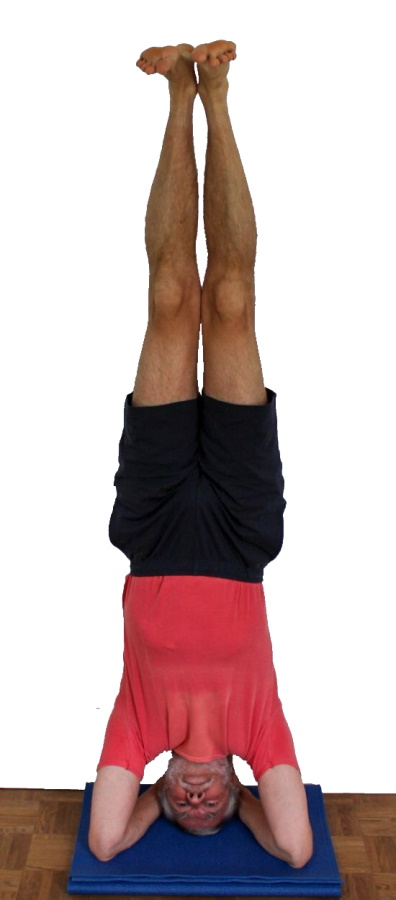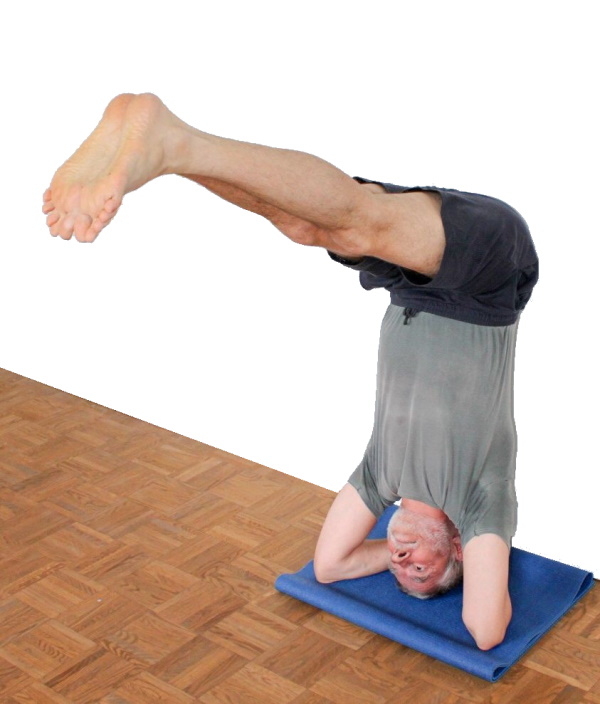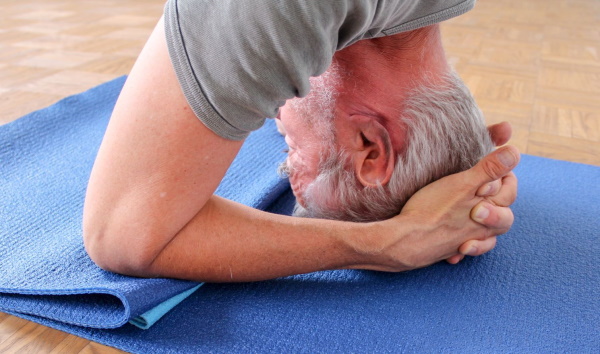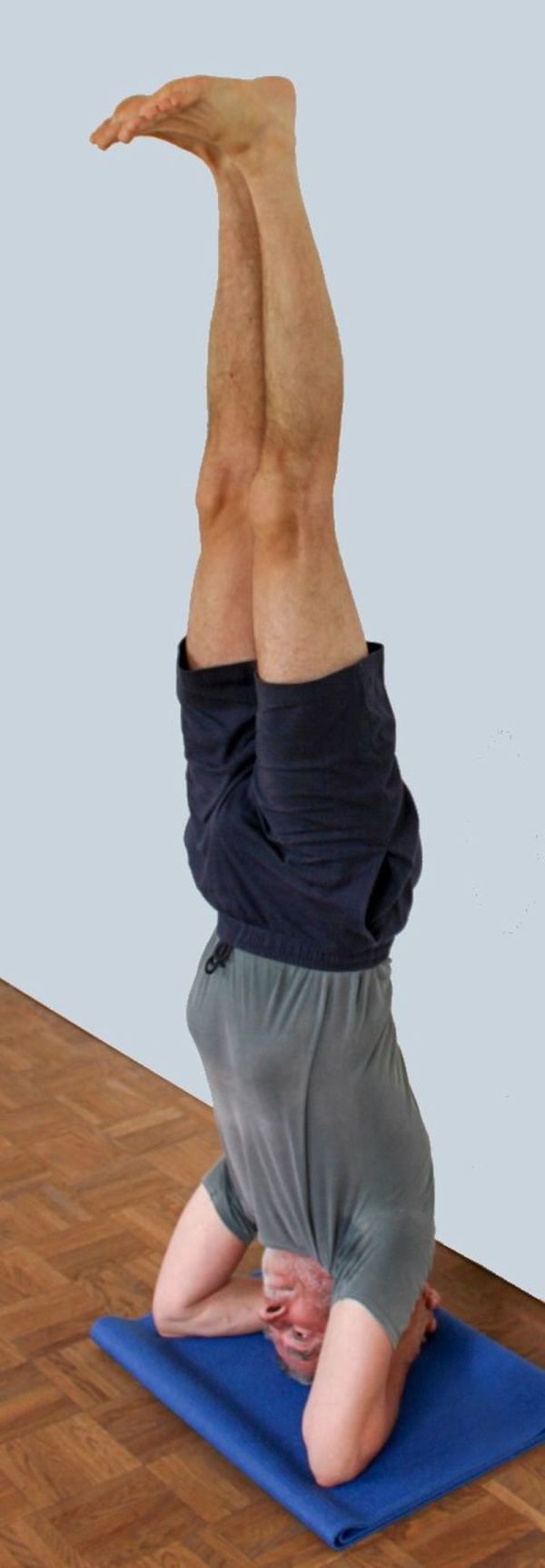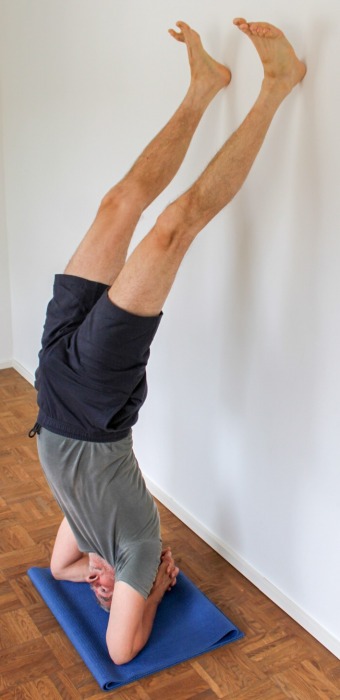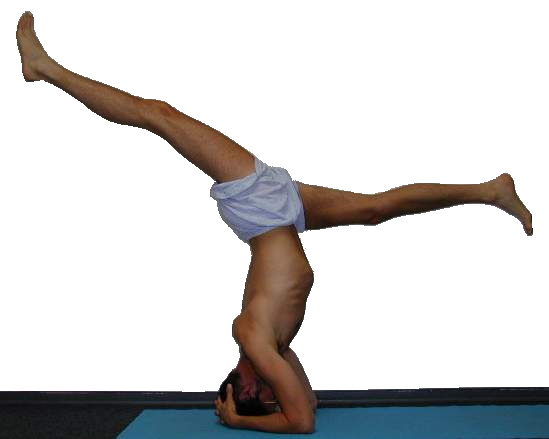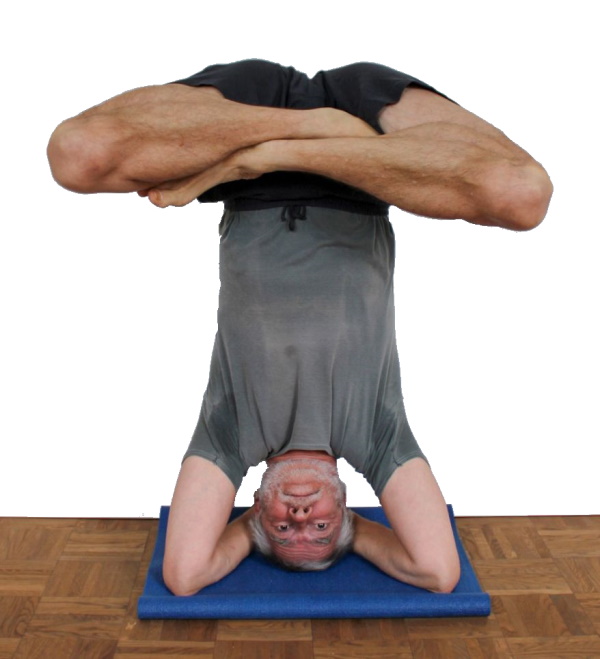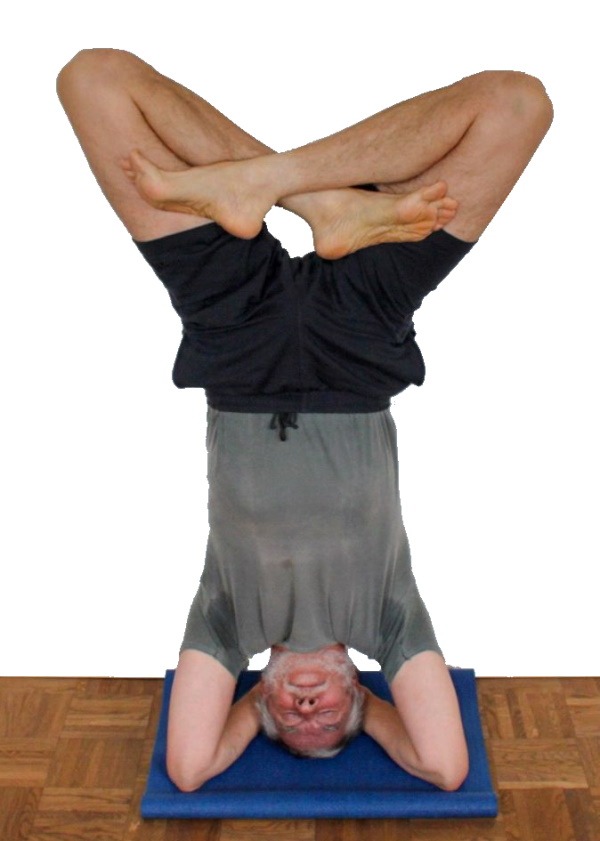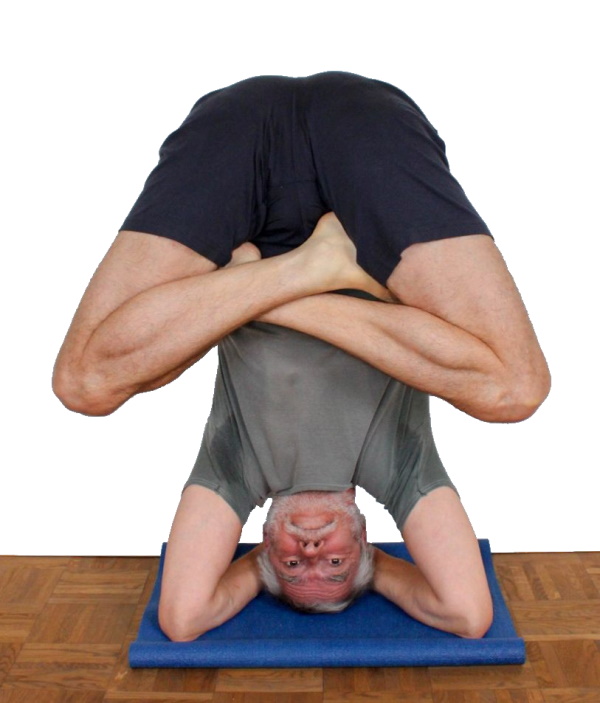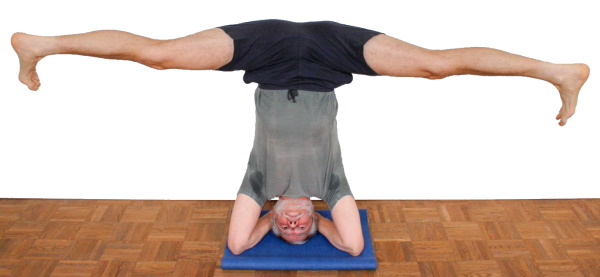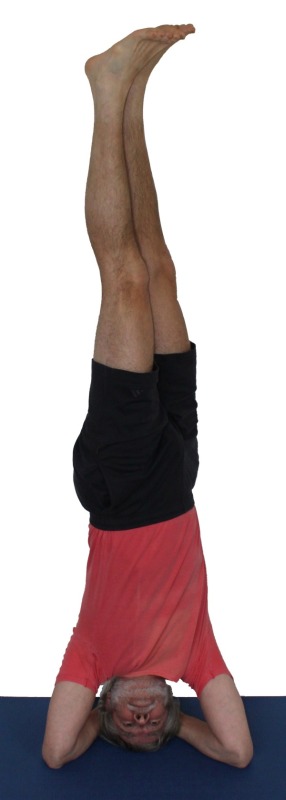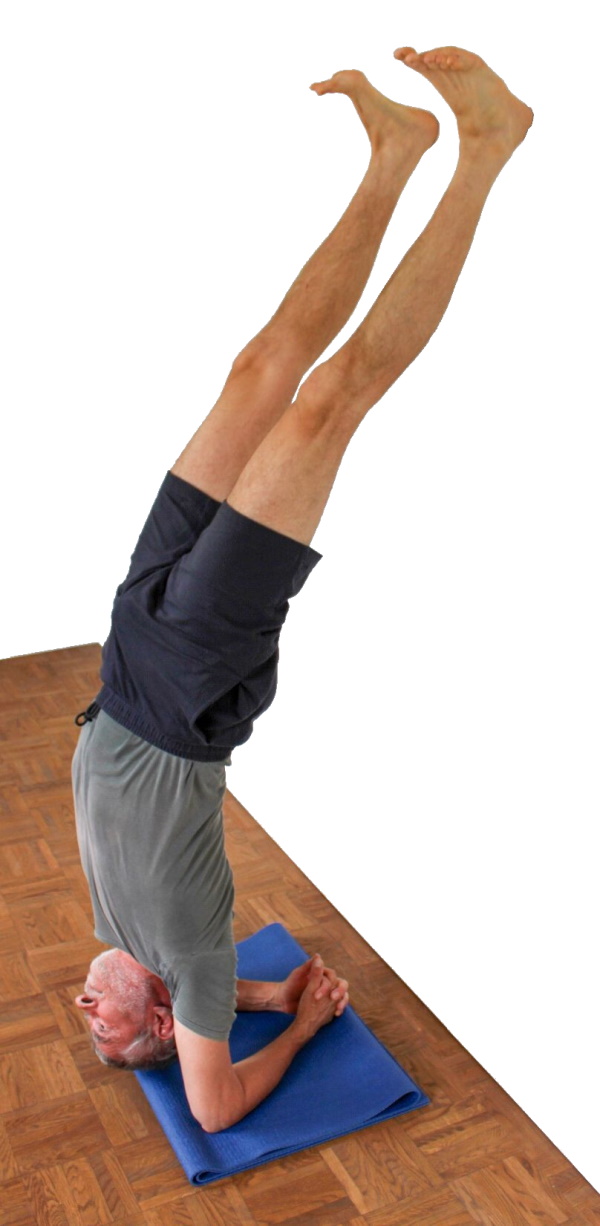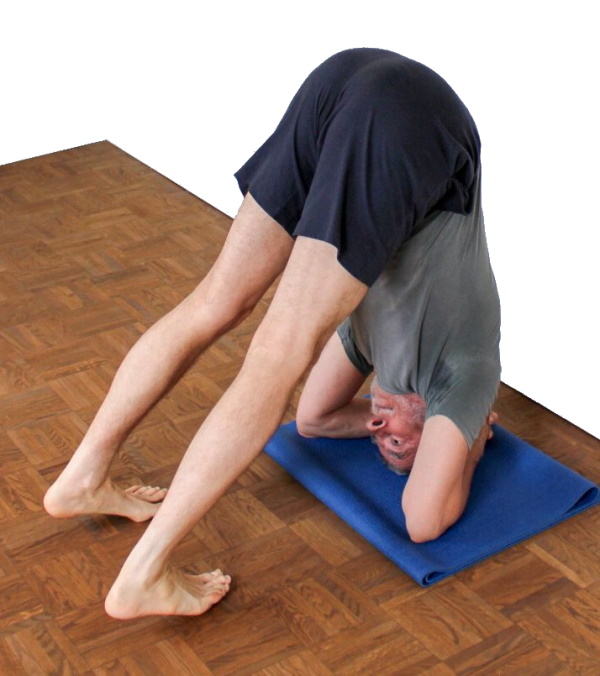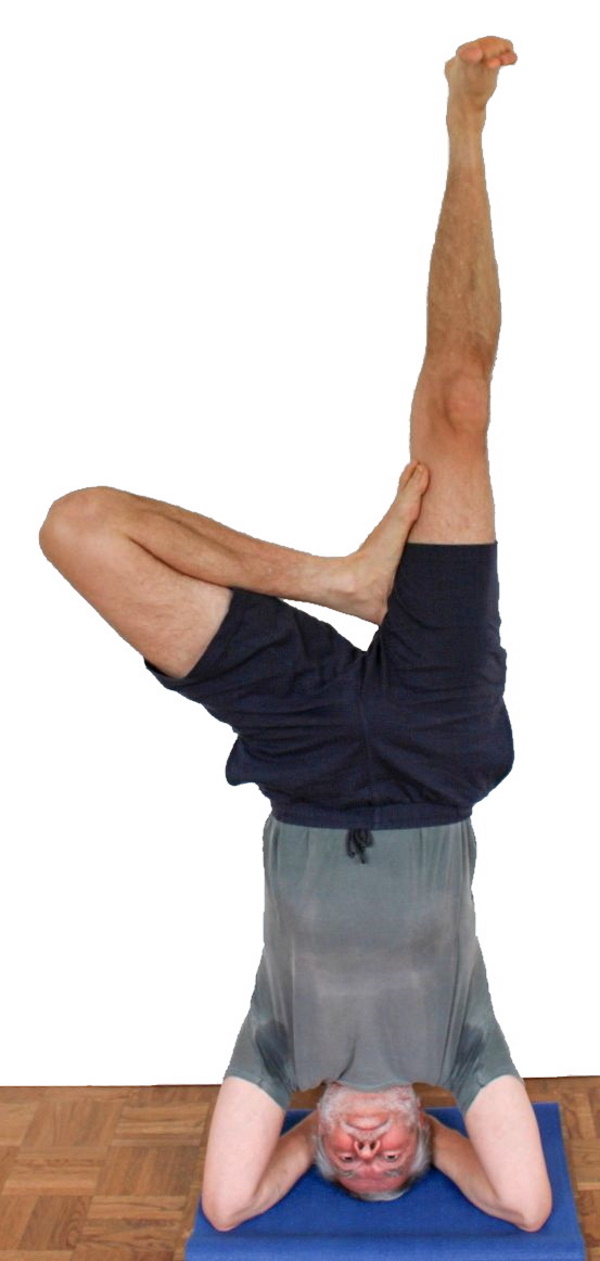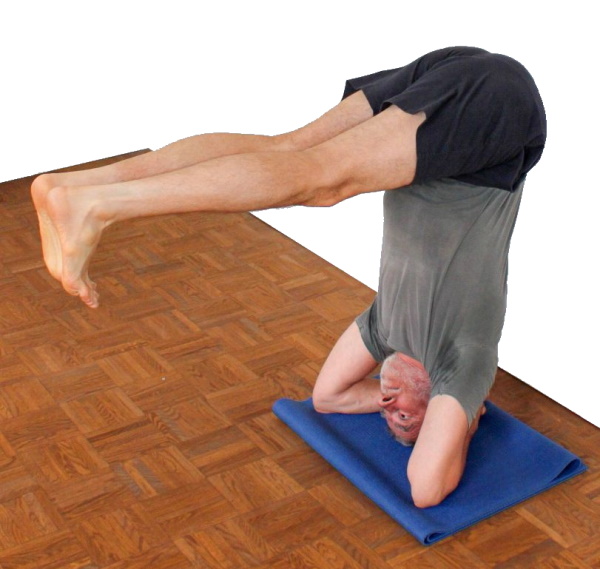- sit upright, stretch your head to the ceiling and reach up to the top of the head
with your arched palm to find the highest point of the head. From this point forward
is a relatively flat area where you are supposed to stand on. For most people, the highest point
of the head is approximately at the beginning of the last third of the
head (seen from the front), but for some, it may also be further forward.
- interlock your fingers firmly. Place the small finger underneath in front
of the other little finger on the inside of the hand, so that it is not squeezed.
- Move the wrists as far apart as possible
- use a twice-folded yoga mat (i. e. 4 layers on top of each other) as a base.
- put your hands with your forearms on the mat so that the elbows are shoulder wide.
- run with your feet so far in front towards the head that the pelvis stands about above
the shoulders; keep your back as straight as possible and make sure not to
change the area with which your head is standing on the ground.
- put maximum weight on hands and arms
- lift one stretched leg and swing it up and down to estimate the possible momentum
- with a strong swinging up of the leg jump off with the other leg. When the first leg
touches the wall, pull the second leg forward towards the wall.
- Stretch the knees, turn in the legs slightly and hold the pelvis upright with
a little work of the butt muscles.
|
- headstand is the much more advanced exercise compared to handstand
The handstand (on the wall) should be mastered to a certain extent before the first
headstand is practiced. The focus is on the ability to lift the upper part
of the body using the strength of the shoulders and arms, as well as the
ability to control the swaying that occurs.
- the twice-folded yoga mat is a good measure of the maximum thickness and softness
of the mat. Any further layer of mat or any softer material is suitable to make
the headstand more shaky and usually costs much more power due to more
complex balance work. On soft surfaces such as carpet, two layers of matt may be optimal.
Fluffy blankets are not recommended, as the lateral movement of the elbows
can hardly be prevented by the beginner.
- when positioning the elbows note that they slide about 3 - 5 cm apart over the flesh of the forearms. After that, the elbows should still be shoulder-width. In some cases of very stiff shoulders, this requirement may have to be put into perspective.
- for practice purposes, the elbows can also be positioned narrower than the shoulder
width for advanced practitioners
- there are two ways to move your arms in the pose:
- apart: the simpler version, increased work with the shoulder muscles possible, safe standing
- inside: completely different work with the arms, slightly less stable stand
- Since the balancing mainly takes place in the direction forward/backward, the safety
of standing depends essentially on the trapezium, which is formed from the two
wrists and the two elbows. This means that if the elbows are clearly wider than
the shoulder width the elbows make the trapezium less high and the standing
position less stable.
- becoming familiar with headstand takes place in several phases:
- Beginning of the head standing exercise: it mostly cannot be done longer
than 2-3 minutes, after which the pressure on the skull plate
will subjectively be perceived as "too high".
- Get used to the pressure on the skull plate, until about 5 minutes, next topic
will be the neck muscles.
- the problem of the neck is also solved slowly, the area between the
shoulder blades becomes interesting: up to about 10 minutes.
- the sensation for the area between the shoulder blades gradually fades and
the sensation of the tonus of the muscles in the lumbar region
becomes apparent, up to 15-20 minutes.
- with correct slight turning in the thighs and completely neutral hip position
in terms of extension/flexion, the leg adductor area may come into play.
- due to stretching the heel up the area of the dorsal flexors of the ankle come into play
Of course, there are many deviations from the sequence described above
based on the respective constitution
- after a longer headstand (for beginners even after a shorter headstand) it
can be quite relaxing for the neck to drop the forehead on the ground. In the beginning, there may a a clear unpleasant perception of the muscles between the upper part of the shoulder blades, but this should fade after 2 - 3 minutes.
- for more therapeutic purposes, the place where you stand on the head can
be changed. In case of relocation to the
- front: there is a larger cavity in the neck, which makes these muscles work more,
but considering the angle range of the affected joints this may also
require a more extensive after-treatment of the muscles. Not recommended for necks already strained before the performing the headstand
- rear: there is less caving of the neck, which makes the muscles work less
in view of the more favourable angle in the vertebral joints.
can be recommended with restrictions for neck already strained
before execution of headstand.
Cave: the pressure on the skullcap increases because the contact area becomes smaller.
In addition, the further the contact area is shifted towards the crown of the head,
the less stable this design is.
- the headstand can in many cases be very effective against headache.
Be careful in assessing the phenomenon. It is not about migraine headache.
For many people, the term migraine still stands for a stronger headache,
but this is a condition based on different causes and mechanisms.
In no way should migraine be treated with the usual headache remedies,
nor should it be treated with the (positively polar) headstand,
but rather with the (negatively polar) shoulderstand. It should not be
treated with the usual headache treatment, nor with the (positively polar)
headstand, but rather with the (negatively polar) shoulderstand.
If not migraine but headache is given, it may have the following
causes and manifestations, among others:
- Pressure or pounding in the head as a result of colds, hypothermia or
draughts felt in immobility but in particular in movement or strain
- throbbing after alcohol or drug use, esp. in movement or strain
- sensation of tension in the neck with continuation in the lower and
middle back of the head (where the affected muscles begin)
in all of the above-mentioned cases, as a rule headrest provides relief or elimination
of the discomfort by significantly increased blood circulation in the head
(due to the reversal position) or by prolonged, calm use of the tense musculature.
Mostly a significant initial worsening occurs after taking headstand, which usually
eases off after about the 3rd to 4th minute and is then outweighed by the onsetting relief.
- headstand as a complete reversal pose that can be kept for a long time is
naturally an interesting requirement for the cardiovascular system.
Thus, in the case of a longer headstand, every beginner and also advanced
user (then later on) suffers a bloodless state in the feet and maybe in
the lower legs, which may feel like a "falling asleep" of the affected
body parts and, due to largely empty vessels, also through paler skin.
This poses less of a health hazard than an impairment of well-being.
At the end of the headstand the re-circulation of blood in the feet
often results in an intensive red-orange-coloured glow of the feet
combined with an intensive feeling of warmth. If you want to prevent
your feet from falling asleep, you can, for example, bring your feet into
the same pose as in baddha konasana when you perceive the beginning
of the falling asleep. This is usually enough to prevent the feet
from falling asleep and to stand in your headstand for a few more minutes.
- The question arises again and again about the weight with which the head
is supposed to press on the ground. The answer is simple:
for the more advanced, it can be maximized, unless a certain powerful
effect should be achieved on the back and shoulder muscles.
For beginners, choose the weight according to skill and tolerance up to complete relief of the head.
- When swinging up and down a leg before taking headstand, make sure that this
leg remains stretched so that you don't immediately push yourself off
the wall again.
- for more advanced students, the slow, two-legged upswing into the headstand is recommended.
- Slightly turning in the legs in an upright pelvis is a similar work as in back
bends. Due to this work, fatigue of the adductor muscles may occur after some time.
- The stretching away of the heels doesn't mean that the balls of the feet should
be pulled with force, which might quickly lead to fatigue of the shin muscles.
This movement serves to give better attention to the movement of the whole
legs in balancing. If the calf muscles are clearly inflexible, it may be
necessary to cut back on stretching away the heel in order to avoid cramps.
- The neck and muscles between the shoulder blades can feel quite tense after
headstand. There are two ways to turn that off:
- sit on the lower legs and put your forehead on the floor (balasana, child's pose)
- Coming from headstand (best synchronized with stretched legs) in uttanasana
In both cases, the muscles in the neck and upper back area are more or
less clearly perceived, in the latter case also other parts of the back muscles, such as the
erector spinae both are harmless and usually disappear within the first 1 to 3 minutes.
| known issues that may occur even when practicing correctly |
|
|
